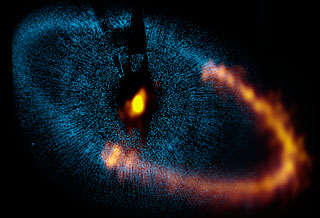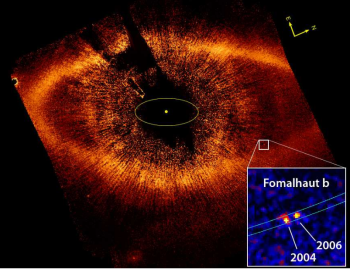Two exoplanets in a tight orbital dance.
Two exoplanets in a tight orbital dance.
“These are the closest two planets to one another that have ever been found,” Agol said. “The bigger planet is pushing the smaller planet around more, so the smaller planet was harder to find.”
Orbiting a star in the Cygnus constellation referred to as Kepler-36a, the planets are designated Kepler-36b and Kepler-36c. Planet b is a rocky planet like Earth, though 4.5 times more massive and with a radius 1.5 times greater. Kepler-36c, which could be either gaseous like Jupiter or watery, is 8.1 times more massive than Earth and has a radius 3.7 times greater.
But wait, there’s more!
The fact that the two planets are so close to each other and exhibit specific orbital patterns allowed the scientists to make fairly precise estimates of each planet’s characteristics, based on their gravitational effects on each other and the resulting variations in the orbits. To date, this is the best-characterized system with small planets, the researchers said.
They believe the smaller planet is 30 percent iron, less than 1 percent atmospheric hydrogen and helium and probably no more than 15 percent water. The larger planet, on the other hand, likely has a rocky core surrounded by a substantial amount of atmospheric hydrogen and helium.
Two exoplanets in a tight orbital dance.
“These are the closest two planets to one another that have ever been found,” Agol said. “The bigger planet is pushing the smaller planet around more, so the smaller planet was harder to find.”
Orbiting a star in the Cygnus constellation referred to as Kepler-36a, the planets are designated Kepler-36b and Kepler-36c. Planet b is a rocky planet like Earth, though 4.5 times more massive and with a radius 1.5 times greater. Kepler-36c, which could be either gaseous like Jupiter or watery, is 8.1 times more massive than Earth and has a radius 3.7 times greater.
But wait, there’s more!
The fact that the two planets are so close to each other and exhibit specific orbital patterns allowed the scientists to make fairly precise estimates of each planet’s characteristics, based on their gravitational effects on each other and the resulting variations in the orbits. To date, this is the best-characterized system with small planets, the researchers said.
They believe the smaller planet is 30 percent iron, less than 1 percent atmospheric hydrogen and helium and probably no more than 15 percent water. The larger planet, on the other hand, likely has a rocky core surrounded by a substantial amount of atmospheric hydrogen and helium.


